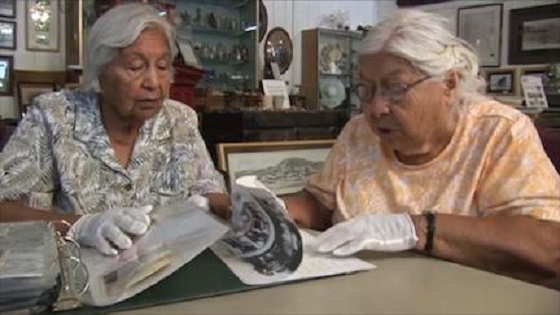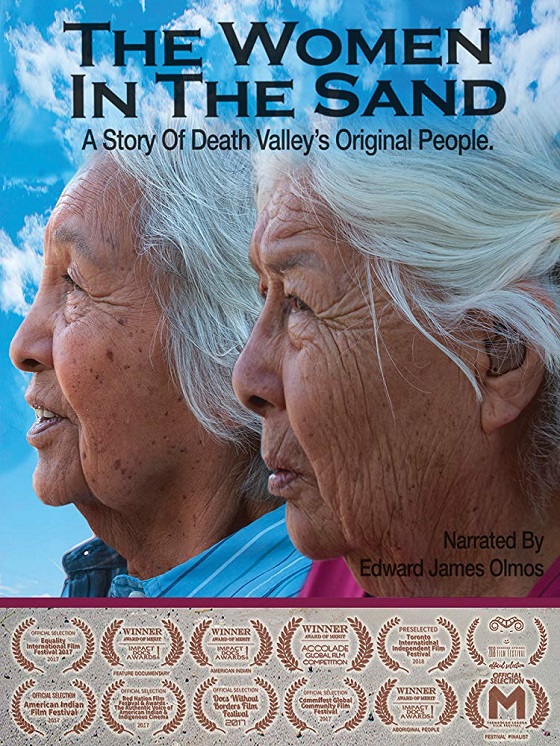Movie Review
Details
Blu-ray Review
Trailer
Art

Tales of silver and gold. Yes, this documentary has its origins in that of greed and power. Our history concerning the treatment of indigenous people is not a pretty one. Thus, The Women in the Sand is also a heartbreaking story that, unfortunately, took place (and still does) in this country. But, on the flip side, it is also a story of survival and, dressed in those clothes, that’s where this documentary, now available on streaming platforms, gets its glory: these women are silent no more.
The Native Americans at the center of The Women in the Sand: A Story of Death Valley’s Original People are Pauline and Madeline Esteves, matriarchs of a tribe that is dwindling for a number of reasons. But these women are strong spiritually and stronger still in their faith. Their stories, full of joy and of struggles, are recounted here and circulate around fighting the powers that be and the intricate art of basket weaving: they are the preservers of a culture whose days are numbered.
Death Valley, as originally discovered by those seeking the wealth that gold would bring during the late 1840s, was deemed as uninhabitable. No one could survive in the hottest place on earth. Barren, dry, and full of ancient haunts left bone-dry and starkly beautiful and yet many were forced here.
This area, right next to Highway 190, is a household to someone: the TRUE elders of Timbisha Shoshone Native Americans. The Women in the Sand is their story and, detailing the strength and the struggles while running through the myths that the white civilization – being the dominant culture – spread about the tribes in the valley, this film gives presence to a long neglected group of survivors who were told, time and time again, to move and move and move.
Think of what these women went through and what their stories MUST entail for just a moment as they were told not to speak their language; to stop their dancing; and assimilate into the dominant culture. Death Valley is their home.
These mountains, once fertile and then pulled apart, have created quite the far-ranging and far-reaching territory. It is not just hot and dry. This is an ancient place of peaks and valleys and shifting temperatures; it is full of legends because it is, in fact, a living and breathing current HOME to them; they are at one with their surroundings. And these people, saving their culture from oppressive forces, are the Timbisha Shoshone Native Americans.
Time itself is now their enemy.
Presented by Leftwood Pictures, director Steve Jarvis shows viewers a harrowingly beautiful documentary about a group of female survivors holding onto a legacy that those in power – this American government – cares little about. These women, as they are STILL being mentors to younger native teens, continue to be shining examples to their tribe, fighting to stay alive as they travel from one resource to another as they confront all manner of struggles. {googleads}
While the youth struggle with their ceremonies, moving way for jobs and schools, these women – whether activists or artists – keep their homes in Death Valley: they will survive as the movie suggests “right smack in the middle of the sand” because, by God, their fight is one of firmness and courage. They know what is right for their land and this involves the colors of the mountains – sometimes white and sometimes blue – as they utilize the land, rage against silly laws, and continue to fight for their right to the land.
This illuminating documentary is narrated by Edward James Olmos and is filled with stories from a group of natives who have gathered to protect their dances, their customs, and their culture. Their stories are tragic, yes, but their struggles – especially when they are sent away to various Indian Schools in an effort to disassociate themselves from their own culture – are documented here so that NO ONE CAN FORGET. History has a nasty way of repeating, though. 
There is a beauty with these people, just as there is a beauty with this land. That is evident by the time and the detail the camera picks up and spends with these women. Beauty like none I have seen before. This is a wonderful documentary that will bring tears to your eyes with its tales and its scenery.
The filmmakers behind The Women in the Sand understand that creating for the viewer a very unique story about indigenous people living and fighting for every single breath, moment, and tear ever shed takes skill and patience and it is all in front of the camera here. This is a documentary that you should NOT miss.
The Women in the Sand can ONLY be viewed on Amazon.com.


MPAA Rating: Unrated.
Runtime: 73 mins
Director: Steve Jarvis
Writer: Steve Jarvis
Cast:
Genre: Documentary
Tagline: A story of Death Valley's original people.
Memorable Movie Quote: "This is the hottest place on Earth. Death Valley California."
Theatrical Distributor:
Official Site: www.leomarkstudios.com/wits.html
Release Date: November 16, 1976
DVD/Blu-ray Release Date: October 11, 2016
Synopsis:
Guided by the spirits of their ancestors, a few feisty elders of the vanishing Timbisha Shoshone Tribe struggle to overcome government injustice and Tribal Council apathy to protect their homeland and keep their ancient tribal language and culture alive in the hottest places on Earth; Death Valley, Caliornia.
{googleads}

![]()
Blu-ray Details:
No details available.

New in Theaters/VOD
New on Home Video






















